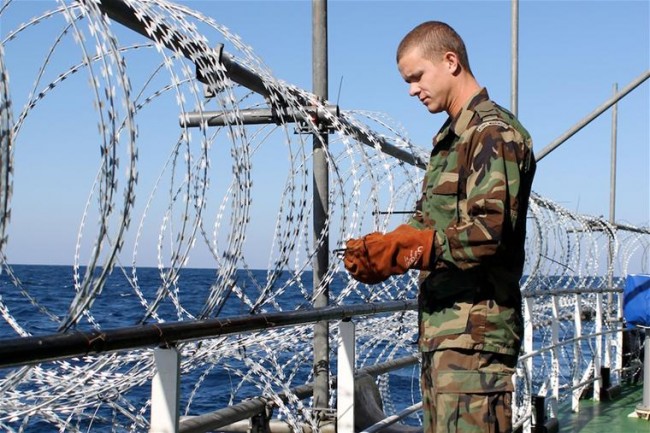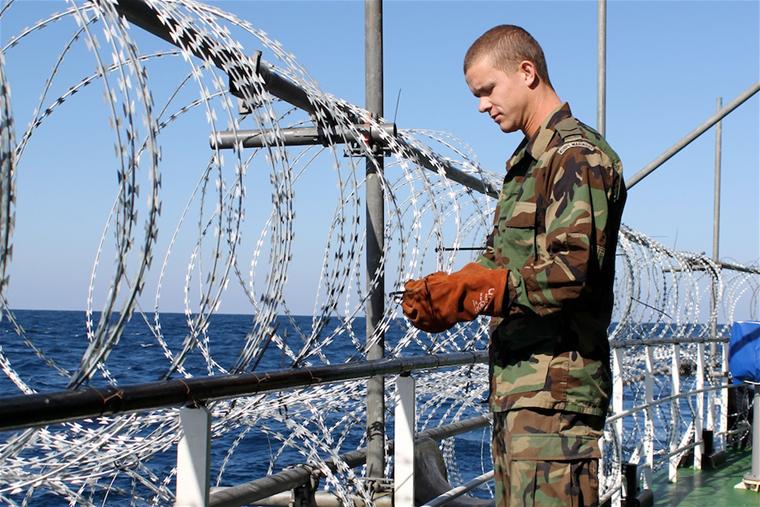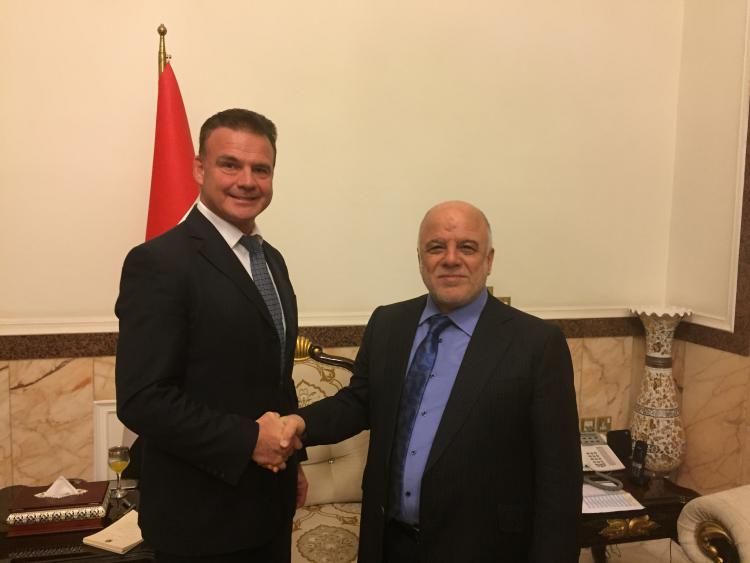Dutch marines pioneer the concept of aVPD

(BRUXELLES2, exclusive) This is probably a little known fact. But it is an on-board military team (EPE in French, VPD in English) which is currently protecting the ships of the World Food Program (WFP) supplying Somalia. Essential aid: approximately 1,7 million people in this country depend on international food aid. A detailed concept presented in Brussels during a seminar on piracy in which B2 participated.
Accompanying WFP ships is the primary and original mission of the EU's anti-piracy operation. Without this action, it seems unlikely that this operation could have seen the light of day. But it is not an easy task, every day, to hear European officers. Some WFP boats are old, sluggish boats. And their accompaniment therefore takes much longer than on a modern ship. WFP's programming is not the most precise either. The unloading or loading of the food ship is often subject to various port requirements, more or less unpredictable. Difficult then to stick to the planned schedule; the soldiers must then wait, which is not without consequences for the other missions.
The concept of autonomous VPAs (aVPD) is therefore a "huge relief" for the Eunavfor mission. That " removes a beautiful thorn from our side - confirms Captain Gelly (from Eunavfor) -, this allows us to release at least one warship, or even more, between fetching a ship, accompanying it, and then recovering it ". In practice, almost a third of the European mission's fleet is thus freed up and can be used for other actions such as observation patrols along the Somali coast or the "race" for hackers.
The concept of Autonomous VPD
An aVPD should be considered as a “ military entity in its own right - unlike a VPD dependent on a warship, an organic extension of this ship". It requires the agreement of the flag State, the shipowner, the tacit agreement and direct agreement with the captain, who is solely responsible on board. " We haven't even defined a VPD size standard. It is a free contribution policy. Each member country proposes what it wishes. We then work with the WFP to fit out the boat” explains CV Gelly.
This concept is however not entirely new since it has been used - with success by the French - on board fishing vessels. And is also used by the Dutch, recently, to protect certain sensitive merchant ships, as well as by the Italians (with the disappointment that we know with the death of two fishermen and the dispute with India). On the other hand, within a multinational operation, it is a first.
The establishment of VPD required intense diplomatic and legal preparation. The European Union has, in fact, had to sign agreements with the flag States of WFP ships. Eunavfor has thus signed six agreements today, first with Liberia, St Vincent & Grenadines, Sierra Leone, then with the Marshall Islands, Panama, Antigua & Barbuda which have accepted that European VPD teams embark on board ships flying their flag.
Resident marines on the Caroline Scan
On the Caroline Scan, a modern ship chartered by the World Food Programme. Let us specify "modern" because apparently this is not the case for all ships, for some, sailing is apparently a "miracle". The 18 Dutch marines had to find their place, which is not easy on a ship, a hundred meters long but above all intended to bring a maximum of freight. Housing has thus been fitted out in containers on the deck, containers with air conditioning. The Dutch team is rather larger than other countries. It has all the equipment to be able to respond to fire, including a heavy machine gun. " “Staff must be capable at all times of being able to deal with an attack” says a Dutch officer. It also has a medical team - doctor, nurse - and the necessary equipment (oxygen, resuscitation, etc.) to guarantee all the care to the teams and have some autonomy.
Rules of Engagement and Shooting
The VPDs remain subject to military discipline and specific fire engagement rules. Rules that differ slightly from the simple "self-defense" to which private guards are bound. The soldiers can act, according to a gradation of means, so as to prevent an attack and not only if a first shot hits them (self-defence). There is a gradation of deterrence: first with warning messages broadcast by radio and deterrent fire. The goal is really to deter pirates from attacking the ship ". " The use of force is based on principles of proportionality and subsidiarity: force should only be used if there is a threat, and no other means available. The use of force is limited. Pirates cannot be prosecuted in this way. This does not mean that force cannot be used only when there is an attack and triggering fire by pirates. Self-defense can be triggered as soon as there is an attack” testifies a Dutch officer. In the event of an attack, there is a distribution of tasks on board between the captain, responsible for the running of the ship, and the commander of the VPDs, for security.
The delicate question of weapons
The question of carrying weapons on board remains a delicate point. The Dutch have an ammunition reserve in Malta (*) where some equipment is stored. Going through Suez requires some formalities. " We must unload the weapons before the passage and recover them at the exit - the Egyptian authorities transport on land - this requires additional diplomatic contacts and the payment of a tax. This transfer is obviously not free. " It is not extremely expensive per unit. But there is a multiplier effect to the number “says our officer.
Frozen fees
Part of the costs are normally covered by the common budget (Athena mechanism): housing, the cost of satellite communications (even if it is, in practice, difficult to isolate these expenses) and transfers. This is for the moment theoretical, because the budget line of 1,8 million euros provided for in the Community budget is frozen. Two countries - Germany… and the Netherlands - have particularly campaigned for this freeze. (Ironically, abstain :-). A future meeting of the Athena committee is supposed to discuss the possibility of "unfreezing" the budget line.
Only one offer
Only one Member State has so far made an autonomous VPD offer, but others could follow: Italy for example. And at Northwood, contributions are expected” interesting for the second half of 2012 and especially in 2013. The Netherlands also uses the autonomous VPD technique to accompany merchant ships flying the flag of the Kingdom. " We currently have 4 simultaneous VPD teams, which transit for approximately 3 weeks. And we plan to use 60 VPD teams per year. But we are working to enhance the device “says our Dutch interlocutor. " If we can transport the team, from one ship to another we do it, they stay there for a few days… Complications are often significant when the equipment is brought in by air. »
(*) One can wonder if there would not be some savings and possible synergies, in particular by establishing this stock in Djibouti in the French base or at the FHQ of Atalanta, or even in Reunion or Mayotte (department French)
